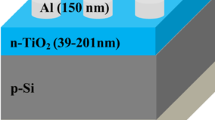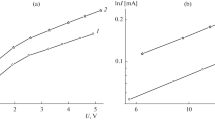Abstract
A promising direction in photovoltaic and heat power engineering is the development of highly efficient photothermovoltaic (РTV) systems to convert the thermal energy of heated bodies into electrical energy. They have important advantages over other thermal power devices. It is known that heating negatively affects the operation of many semiconductor devices, but it increases the efficiency of photothermovoltaic element. The process of the appearance of voltage and electric current in the p-Si–n-(Si2)1 – x – y (Ge2)x(ZnSe)y structure during uniform heating both in the dark and in light was studied in this work. The uniform heating of the p‑Si–n-(Si2)1 – x – y(Ge2)x(ZnSe)y heterostructure both in the dark by thermal heating and photoheating and in light by solar radiation generated an electric current and a potential difference. The dark current generated by photoheating in the studied temperature range has a greater value of three orders of magnitude than in the case of thermal heating. However, the potential difference generated by photoheating slightly decreases with increasing temperature, but its value is almost two orders of magnitude greater than in the case of thermal heating. There is also a slight decrease in the photocurrent and potential difference at increasing temperature. Since the composition of the substrate-film intermediate region changes continuously from Si to the p-Si–n-(Si2)1 – x – y(Ge2)x(ZnSe)y epitaxial film, a graded-gap layer with a smoothly varying composition prevents breaks in the energy zones of the p–n structure. Due to the variability in the intermediate region, an energy barrier arises, mainly for holes, which contributes to the appearance of an additional separating field, which is determined by the gradient of the band gap of this layer. Therefore, the hole current in this structure that is caused by photothermally generated electron-hole pairs can be significant up to higher temperatures. The low efficiency of the studied structure is clearly associated with the recombination of the main parts of the photothermally generated charge carriers.

Similar content being viewed by others
REFERENCES
Saidov, A.S., Leyderman, A.Yu., Ayuhanov, R.A., et al., Spectral photosensitivity of polycrystalline silicon obtained by five function of relief of metallurgic silicon in sun furnace, Altern. Energy Ecol., 2012, no. 4, pp. 42-47.
Saidov, A.S., Leiderman, A.Yu., Khashaev, M.M., and Rakhmonov, U.Kh., Thermovoltaic synergrtic effects of self-organization of impurities and defects in semiconductors of type AIIIBV, Al’tern. Energet. Ekol., 2015, vol. 7, pp. 55–69.
Leyderman, A.Yu., Saidov, A.S., Khashaev, M.M., and Rakhmonov, U.Kh., Study of properties of tellurium-doped indium phosphide as photoconversion material, Appl. Sol. Energy, 2014, vol. 50, no. 3, pp. 143–145. https://link.springer.com/article/10.3103/ S0003701X14030098.
Saidov, A.S., Leiderman, A.Yu., and Karshiev, A.B., The thermoelectric effect in a graded-gap nSi–pSi1 – xGex heterostructure, Appl. Sol. Energy, 2016, vol. 52, no. 2, pp. 115–117. https://link.springer.com/article/10.3103/ S0003701X16020122
Kaminskii, V.V., Kazanin, M.M., Klishin, A.N., et al., Thermovoltaic effect in samarium sulfide–based heterostructures with Sm1 – xEuxS compound, Zh. Tekh. Fiz., 2011, vol. 82, no. 6, pp. 142–144.
Kazanin, M.M., Kaminskii, V.V., Solov’ev, S.M., Anomalous thermal electromotive force in samarium monosulfide, Tech. Phys., 2000, vol. 45, no. 5, pp. 659–661.
Kaminskii, V.V. and Solov’ev, S.M., Emf induced by a change in the samarium ion valence as a result of a phase transition in SmS single crystals, Phys. Solid State, 2001, vol. 43, no. 3, pp. 439–442.
Kaminskii, V.V., Vasil’ev, L.N., Romanova, M.V., and Solov’ev, S.M., The mechanism of the appearance of an electromotive force on heating of SmS single crystals, Phys. Solid State, 2001, vol. 43, no. 6, pp. 1030–1032.
Kaminskii, V.V., Golubkov, A.V., and Vasil’ev, L.N., Defect samarium ions and electromotive force generation in SmS, Phys. Solid State, 2002, vol. 44, no. 8, pp. 1574–1578.
Groshev, I. and Polukhin, I., Samarium sulfide and the latest developments based on it, Kompon. Tekhnol., 2014, vol. 8, pp. 126–133.
Kaminskii, V.V., Didik, V.A., Kazanin, M.M., Romanova, M.V., and Solov’ev, S.M., Thermovoltaic effect in polycrystalline samarium sulfide, Tech. Phys. Lett., 2017, vol. 60, no. 4, pp. 981–984.
Kaminskii, V.V., Kazanin, M.M., Klishin, A.N., Solov’ev, S.M., and Golubkov, A.V., Thermovoltaic effect in samarium sulfide–based heterostructures, Tech. Phys., 2011, vol. 56, no. 6, pp. 893–895.
Pronin, I.A., Averin, I.A., Bozhinova, A.S., Georgieva, A.Ts., Dimitrov, D.Ts., Karmanov, A.A., Moshnikov, V.A., Papazova, K.I., Terukov, E.I., and Yakushova, N.D., The thermovoltaic effect in zinc oxide inhomogeneously doped with mixed-valence impurities, Tech. Phys. Lett., 2015, vol. 41, no. 19, pp. 930–932.
Pronin, I.A., Yakushova, N.D., Dimitrov, D.Ts., Krasteva, L.K., Papazova, K.I., Karmanov, A.A., Averin, I.A., Georgieva, A.Ts., Moshnikov, V.A., and Terukov, E.I., A new type of gas sensor based on the thermovoltaic effect in zinc oxide inhomogeneously doped with mixed-valence impurities, Tech. Phys. Lett., 2017, vol. 43, no. 18, pp. 825–827.
Bavykin, V.V., Kalinin, Yu.E., Kanivets, L.V., and Shuvaev, A.S., Thermovoltaic effect in two-layer structure [Cu2O]90[Cu2Se]10 – [Cu2O]60[Cu2Se]40, Vestn. Voronezh. Tekh. Univ., 2015, no. 4, pp. 89–92.
Leiderman, A.Yu., Saidov, A.S., Khashaev, M.M., and Rakhmonov, U.Kh., Study of GaSb doped with Te as a material for photovoltaic systems, Appl. Sol. Energy, 2015, vol. 51, no. 2, pp. 117–119. https://link.springer.com/article/10.3103/S0003701X15020061
Kadyrov, A.L., Theoretical interpretation of the occurence of EMF at homogeneous heating of isotypic micro-grained silicon, Izv. Akad. Nauk Resp. Tadzhikistan, 2017, vol. 169, no. 4, pp. 63–70.
Leyderman, A.Yu., Saidov, A.S., and Khashaev, M.M., About possibility of development synergetic processes in semiconductors of type AIIIBV, J. Mater. Sci. Res., 2013, vol. 2, no. 2, pp. 14–21.
Saidov, A.S., Leiderman, A.Yu., and Karshiev, A.B., The thermoelectric effect in a graded-gap nSi–pSi1 – xGex heterostructure, Appl. Sol. Energy, 2016, vol. 52, no. 2, pp. 115–117. https://link.springer.com/article/10.3103/S0003701X16020122
Leiderman, A.Yu., Saidov, A.S., and Karshiev, A.B., Thermoelectric effect in the graded band gap Si1 – xGex (0.2 ≤ x ≤ 1), Si1 – xGex (0.5 ≤ x ≤ 1) solid solutions dependent on the gap difference, Appl. Sol. Energy, 2017, vol. 53, no. 1, pp. 13–15. https://link.springer.com/article/10.3103/S0003701X17010091
Alekseeva, L.V., Antonycheva, E.A., Ivanov, V.I., et al., Thermoelectric element on the basis of the sandwich metal–ferroelectric–metal structure, Usp. Sovrem. Estestvozn., 2016, no. 9, pp. 9–13.
Majumdar, A., Thermoelectricity in semiconductor nanostructures, Science (Washington, DC, U. S.), 2004, vol. 303, no. 5659, pp. 777–778.
Saidov, A.S., Usmonov, Sh.N., Amonov, K.A., Saidov, M.S., and Kutlimuratov, B.R., Photosensitivity of pSi–n(Si2)1 – x – y(Ge2)x(ZnSe)y heterostructures with quantum dots, Appl. Sol. Energy, 2017, vol. 53, no. 4, pp. 287–290. https://link.springer.com/article/10.3103/S0003701X17040132
Andreev, V.M., Dolginov, L.M., and Tret’yakov, D.N., Zhidkostnaya epitaksiya tekhnologii poluprovodnikovykh priborov (Liquid Epitaxy of Semiconductor Device Technology), Moscow: Sov. Radio, 1975.
Hansen, M. and Anderko, K., Structure of Binary Alloys, New York: McGraw-Hill, 1958.
Saidov, A.S., Usmonov, Sh.N., and Rakhmonov, U.Kh., Spectral photosensitivity of pSi–n(ZnSe)1 – x –y-(Si2)x(GaP)y structures, Appl. Sol. Energy, 2010, vol. 46, no. 3, pp. 209–211. https://link.springer.com/article/10.3103/S0003701X10030114
Saidov, A.S., Amonov, K.A., and Kutlimurotov, B.R., Direct solar conversion to electricity nanoscale effects in pSi–n(Si2)1 – x(ZnSe)x (0 ≤ x ≤ 0.01) of solar cells, Appl. Sol. Energy, 2016, vol. 52, no. 1, pp. 1–4. https://link.springer.com/article/10.3103/S0003701-X16010102
ACKNOWLEDGMENTS
The authors would like to thank colleagues from the Physicotechnical Institute SPA “Physics–Sun” of the Academy of Sciences of the Republic of Uzbekistan for their continued support.
Funding
This work was financially supported by an internal grant FA-F2-003 RUz: “Photo-, thermoelectric and radiative effects in new multicomponent solid solutions with nanocrystals based on molecules of elementary semiconductors and semiconductor compounds.”
Author information
Authors and Affiliations
Corresponding author
Additional information
Translated by L. Solovyova
About this article
Cite this article
Saidov, A.S., Usmonov, S.N., Amonov, K.A. et al. Photothermovoltaic Effect in p-Si−n-(Si2)1 –x–y(Ge2)x(ZnSe)y Structure. Appl. Sol. Energy 55, 265–268 (2019). https://doi.org/10.3103/S0003701X19050116
Received:
Revised:
Accepted:
Published:
Issue Date:
DOI: https://doi.org/10.3103/S0003701X19050116




